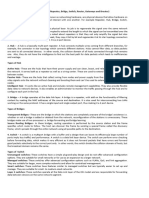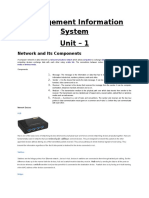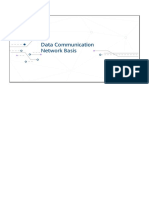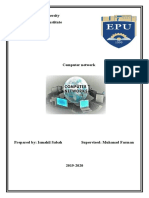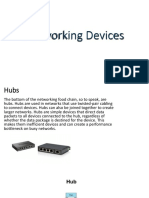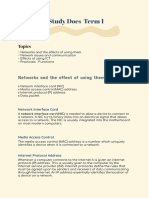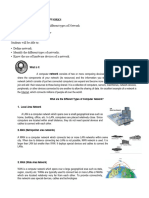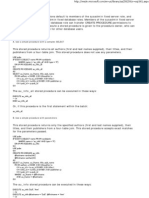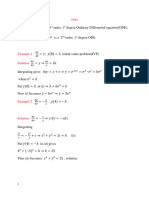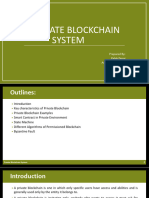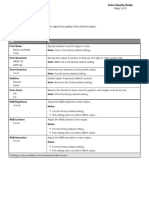Unit - 4
Types of networks
• Local Area Network (LAN): A LAN is a network that covers an area
of around 10 kilometers. For example, a college network or an office
network. Depending upon the needs of the organization, a LAN can be
a single office, building, or Campus. We can have two PCs and one
printer in-home office or it can extend throughout a company and
include audio and video devices. Each host in LAN has an identifier, an
address that defines hosts in LAN. A packet sent by the host to another
host carries both the source host’s and the destination host’s address.
• Metropolitan Area Network (MAN): MAN refers to a network that
covers an entire city. For example: consider the cable television
network.
• Wide Area Network (WAN): WAN refers to a network that connects
countries or continents. For example, the Internet allows users to
access a distributed system called www from anywhere around the
globe. WAN interconnects connecting devices such as switches,
routers, or modems. A LAN is normally privately owned by an
organization that uses it. We see two distinct examples of WANs today:
point-to-point WANs and Switched WANs
Networking Devices
Basic hardware interconnecting network nodes, such as Network Interface Cards
(NICs), Bridges, Hubs, Switches, and Routers, are used in all networks. In
addition, a mechanism for connecting these building parts is necessary, which is
usually galvanic cable and optical cable are less popular (“optical fiber”)The
following are the network devices :
• NIC (Network Interface Card): A network card, often known as a
network adapter or NIC (network interface card), is computer hardware
that enables computers to communicate via a network. It offers physical
access to networking media and, in many cases, MAC addresses serve
as a low-level addressing scheme. Each network interface card has a
distinct identifier. This is stored on a chip that is attached to the card.
• Repeater: A repeater is an electrical device that receives a signal,
cleans it of unwanted noise, regenerates it, and retransmits it at a higher
power level or to the opposite side of an obstruction, allowing the signal
to travel greater distances without degradation. In the majority of twisted
pair Ethernet networks, Repeaters are necessary for cable lengths
longer than 100 meters in some systems. Repeaters are based on
physics.
• Hub: A hub is a device that joins together many twisted pairs or fiber
optic Ethernet devices to give the illusion as a formation of a single
network segment. The device can be visualized as a multiport repeater.
A network hub is a relatively simple broadcast device. Any packet
entering any port is regenerated and broadcast out on all other ports,
and hubs do not control any of the traffic that passes through them.
Packet collisions occur as a result of every packet being sent out
through all other ports, substantially impeding the smooth flow of
communication.
• Bridges: Bridges broadcast data to all the ports but not on the one
that received the transmission. Bridges, on the other hand, learn which
MAC addresses are reachable through specific ports rather than
copying messages to all ports as hubs do. Once a port and an address
are associated, the bridge will only transport traffic for that address to
that port.
• Switches: A switch differs from a hub in that it only forwards frames to
the ports that are participating in the communication, rather than all of
the ports that are connected. The collision domain is broken by a switch,
yet the switch depicts itself as a broadcast domain. Frame forwarding
decisions are made by switches based on MAC addresses.
• Routers: Routers are networking devices that use headers and
forwarding tables to find the optimal way to forward data packets
between networks. A router is a computer networking device that links
two or more computer networks and selectively exchanges data packets
between them. A router can use address information in each data
packet to determine if the source and destination are on the same
network or if the data packet has to be transported between networks.
When numerous routers are deployed in a wide collection of
interconnected networks, the routers share target system addresses so
that each router can develop a table displaying the preferred pathways
between any two systems on the associated networks.
• Gateways: To provide system compatibility, a gateway may contain
devices such as protocol translators, impedance matching devices, rate
converters, fault isolators, or signal translators. It also necessitates the
development of administrative procedures that are acceptable to both
networks. By completing the necessary protocol conversions, a protocol
translation/mapping gateway joins networks that use distinct network
protocol technologies.
Internet
The internet is a larger network that allows computer networks controlled
by enterprises, governments, colleges, and other organizations all over the
world to communicate with one another. As a result, there are a tangle of
cables, computers, data centers, routers, servers, repeaters, satellites, and
wi-fi towers that allow digital data to go around the world.
The Internet is a vast network of networks that functions as a networking
infrastructure. It links millions of computers throughout the world, creating a
network in which any computer can talk with any other computer as long as they
are both linked to the Internet.
The Internet is a global network of interconnected computers that communicate
and share information using a standardized Internet Protocol Suite.
INTRANET
Intranet is a kind of private network. For example, an intranet is used by
different organizations and only members/staff of that organization have access
to this. It is a system in which multiple PCs of an organization (or the PCs you
want to connect) are connected to each other through intranet. As this is a
private network, so no one from the outside world can access this network. So
many organizations and companies have their own intranet network and only its
members and staff have access to this network. This is also used to protect
your data and provide data security to a particular organization, as it is a private
network and does not leak data to the outside world.
FIREWALL
A firewall is a network security device, either hardware or software-based,
which monitors all incoming and outgoing traffic and based on a defined set of
security rules it accepts, rejects or drops that specific traffic.
Accept: allow the traffic
Reject: block the traffic but reply with an “unreachable error”
Drop: block the traffic with no reply
A firewall establishes a barrier between secured internal networks and outside
untrusted network, such as the Internet.
Artificial intelligence
Artificial intelligence is the simulation of human intelligence processes by
machines, especially computer systems. Specific applications of AI
include expert systems, natural language processing, speech recognition
and machine vision.
Before leading to the meaning of artificial intelligence let understand what is the
meaning of Intelligence-
Intelligence: The ability to learn and solve problems. This definition is taken
from webster’s Dictionary.
The most common answer that one expects is “to make computers intelligent
so that they can act intelligently!”, but the question is how much intelligent?
How can one judge intelligence?
…as intelligent as humans. If the computers can, somehow, solve real-world
problems, by improving on their own from past experiences, they would be
called “intelligent”.
Thus, the AI systems are more generic (rather than specific), can “think” and
are more flexible.
Intelligence, as we know, is the ability to acquire and apply knowledge.
Knowledge is the information acquired through experience. Experience is the
knowledge gained through exposure(training). Summing the terms up, we
get artificial intelligence as the “copy of something natural (i.e., human
beings) ‘WHO’ is capable of acquiring and applying the information it has
gained through exposure.”
Intelligence is composed of:
• Reasoning
• Learning
• Problem Solving
• Perception
• Linguistic Intelligence
Many tools are used in AI, including versions of search and mathematical
optimization, logic, and methods based on probability and economics. The AI
field draws upon computer science, mathematics, psychology, linguistics,
philosophy, neuroscience, artificial psychology, and many others.
Machine learning
Machine Learning is the field of study that gives computers the capability to learn without being
explicitly programmed. ML is one of the most exciting technologies that one would have ever
come across. As it is evident from the name, it gives the computer that makes it more similar to
humans: The ability to learn. Machine learning is actively being used today, perhaps in many
more places than one would expect.
Machine Learning, as the name says, is all about machines learning
automatically without being explicitly programmed or learning without any direct
human intervention. This machine learning process starts with feeding them
good quality data and then training the machines by building various machine
learning models using the data and different algorithms. The choice of
algorithms depends on what type of data we have and what kind of task we are
trying to automate.
Data Analytics
Analytics is the discovery and communication of meaningful patterns in data.
Especially, valuable in areas rich with recorded information, analytics relies on
the simultaneous application of statistics, computer programming, and
operation research to qualify performance. Analytics often favors data
visualization to communicate insight.
Firms may commonly apply analytics to business data, to describe, predict, and
improve business performance. Especially, areas within include predictive
analytics, enterprise decision management, etc. Since analytics can require
extensive computation(because of big data), the algorithms and software used
to analytics harness the most current methods in computer science.
In a nutshell, analytics is the scientific process of transforming data into insight
for making better decisions. The goal of Data Analytics is to get actionable
insights resulting in smarter decisions and better business outcomes.
It is critical to design and built a data warehouse or Business Intelligence (BI)
architecture that provides a flexible, multi-faceted analytical ecosystem,
optimized for efficient ingestion and analysis of large and diverse data sets.
IOT
Internet of Things (IoT) is the networking of physical objects that contain
electronics embedded within their architecture in order to communicate and
sense interactions amongst each other or with respect to the external
environment. In the upcoming years, IoT-based technology will offer advanced
levels of services and practically change the way people lead their daily lives.
Advancements in medicine, power, gene therapies, agriculture, smart cities,
and smart homes are just a very few of the categorical examples where IoT is
strongly established.
IoT is network of interconnected computing devices which are embedded
in everyday objects, enabling them to send and receive data.
Main components used in IoT:
• Low-power embedded systems: Less battery consumption, high
performance are the inverse factors that play a significant role during
the design of electronic systems.
• Sensors : Sensors are the major part of any IoT applications. It is a
physical device that measures and detect certain physical quantity and
convert it into signal which can be provide as an input to processing
or control unit for analysis purpose.
DOMAIN NAME
Every computer on the Internet has an address which is unique in nature. It is a
string of numbers and is referred to as IP address. To communicate with each
other, computers identify another computer via its IP address. It is represented
in either dotted decimal notation or in binary decimal notation. Example: The
address 172.16.122.204 when represented like these in dotted-decimal notation
and it can be converted into binary notation. After conversion, it becomes
10101100 00010000 01111010 11001100.
But it is difficult for humans to remember this IP address. Thus to find the
location on the Internet easily, DNS was invented. DNS stands for Domain
Name Server. It implements a distributed database which translates IP address
into a unique alphanumeric address which is referred to as Domain Names.
Basically, a domain name is the sequence of letters and or numbers separated
by one or more period (“.”). It is just like a pointer to a unique IP address on the
computer network. As an analogy one can consider Domain name as
address and DNS as address book of the Internet.
IP Address
All the computers of the world on the Internet network communicate with each
other with underground or underwater cables or wirelessly. If I want to
download a file from the internet or load a web page or literally do anything
related to the internet, my computer must have an address so that other
computers can find and locate mine in order to deliver that particular file or
webpage that I am requesting. In technical terms, that address is called IP
Address or Internet Protocol Address.
The working of IP addresses is similar to other languages. It can also use some
set of rules to send information. Using these protocols we can easily send, and
receive data or files to the connected devices. There are several steps behind
the scenes. Let us look at them
• Your device directly requests your Internet Service Provider which then
grants your device access to the web.
• And an IP Address is assigned to your device from the given range
available.
• Your internet activity goes through your service provider, and they route
it back to you, using your IP address.
• Your IP address can change. For example, turning your router on or off
can change your IP Address.
• When you are out from your home location your home IP address
doesn’t accompany you. It changes as you change the network of your
device.
URL is the abbreviation of Uniform Resource Locator. It is the resource
address on the internet. The URL (Uniform Resource Locator) is created by Tim
Berners-Lee and the Internet Engineering working group in 1994. URL is the
character string (address) which is used to access data from the internet. The
URL is the type of URI (Uniform Resource Identifier).
A URL contains the following information which is listed below:
• Protocol name
• A colon followed by double forward-slash (://)
• Hostname (domain name) or IP address
• A colon followed by port number (optional – unless specified
otherwise, “:80” is the default when using HTTP, and “:443” is the
default when using HTTPS)
• Path of the file
The Client-server model is a distributed application structure that
partitions task or workload between the providers of a resource or service,
called servers, and service requesters called clients. In the client-server
architecture, when the client computer sends a request for data to the server
through the internet, the server accepts the requested process and deliver the
data packets requested back to the client. Clients do not share any of their
resources. Examples of Client-Server Model are Email, World Wide Web, etc.
How the Client-Server Model works ?
In this article we are going to take a dive into the Client-Server model and have
a look at how the Internet works via, web browsers. This article will help us in
having a solid foundation of the WEB and help in working with WEB
technologies with ease.
• Client: When we talk the word Client, it mean to talk of a person or an
organization using a particular service. Similarly in the digital world
a Client is a computer (Host) i.e. capable of receiving information or
using a particular service from the service providers (Servers).
• Servers: Similarly, when we talk the word Servers, It mean a person
or medium that serves something. Similarly in this digital world
a Server is a remote computer which provides information (data) or
access to particular services.
So, its basically the Client requesting something and the Server serving it as
long as its present in the database.
The World Wide Web is abbreviated as WWW and is commonly
known as the web. The WWW was initiated by CERN (European library for
Nuclear Research) in 1989.
WWW can be defined as the collection of different websites around the world,
containing different information shared via local servers (or computers).
It is a project created, by Timothy Berner Lee in 1989, for researchers to work
together effectively at CERN. is an organization, named the World Wide Web
Consortium (W3C), which was developed for further development of the web.
This organization is directed by Tim Berner’s Lee, aka the father of the web.
System Architecture:
From the user’s point of view, the web consists of a vast, worldwide connection
of documents or web pages. Each page may contain links to other pages
anywhere in the world. The pages can be retrieved and viewed by using
browsers of which internet explorer, Netscape Navigator, Google Chrome, etc
are the popular ones. The browser fetches the page requested interprets the
text and formatting commands on it, and displays the page, properly formatted,
on the screen.
Search engine
The word search engine resonates with Google, one of the most powerful and
popular web-searching mediums in use. Any query typed into the Google
search bar returns hundreds of corresponding web pages. The lesser-known
fact however is that the technology backing Google’s incredible ability, falls into
a category of search techniques employed to carry out a swift exploration.
The traditional method of an inquiry into the search box is followed by:
• Search through the search engine database
• Identification of relevant web pages
• Display of Search Engine Result Page (SERP)
All search engines strive to provide the service of delivering relevant pages
from the World Wide Web but the manner in which listings are generated differ
based on the kind of search engine and algorithms used.
Communication Process Definition
The term communication process refers to the exchange of information
(a message) between two or more people. For communication to succeed, both
parties must be able to exchange information and understand each other. If the
flow of information is blocked for some reason or the parties cannot make
themselves understood, then communication fails.
The process of communication involves the following steps:
1. Sender: The person who conveys his thoughts, message or ideas to the
receiver is known as the sender. He is at the starting point of the
communication system and represents the source of communication.
2. Message: The subject matter of communication is termed as messages. It
includes ideas, feelings, suggestions, order, etc., which a sender wants to
convey to the receiver.
3. Encoding: The process of converting messages into communication
symbols, which may be understood by the receiver. It includes words, pictures,
gestures, symbols, etc. Encoding translates the internal thought of the sender
into a language which can be understandable.
4. Media: The path, channel or medium through which encoded message is
transmitted to the receiver is known as media. It is the carrier of the message. It
can be in written form, face to face, through telephone, letter, internet, etc.
5. Decoding: The process of translating the encoded message into an effective
language, which can be understood by the receiver is known as decoding. In
this, the encoded symbols of the sender are converted.
6. Receiver: The person who receives the message of the sender is known as
the receiver.
7. Feedback: In order to complete the process of communication, feedback is
essential. The process of reversal of communication in which the receiver
expresses his reaction to the sender of the message is known as feedback.
Feedback ensures that the receiver has received and understood the message.
8. Noise: Any construction or hindrance which hampers the communication
process is known as noise. The hindrance may be caused to the sender,
message or receiver. It acts as a barrier to effective communication and
because of this message is interpreted differently by the receiver. Disturbance
in the telephone line, inattentive receiver, faulty decoding, poor internet
connection, improper gestures and postures, etc., are some examples of noise.
Data transmission mode
Transmission mode means transferring data between two devices. It is also
known as a communication mode. Buses and networks are designed to allow
communication to occur between individual devices that are interconnected.
There are three types of transmission mode:-
1. Simplex Mode –
In Simplex mode, the communication is unidirectional, as on a one-way street.
Only one of the two devices on a link can transmit, the other can only receive.
The simplex mode can use the entire capacity of the channel to send data in
one direction.
Example: Keyboard and traditional monitors. The keyboard can only introduce
input, the monitor can only give the output.
2. Half-Duplex Mode –
In half-duplex mode, each station can both transmit and receive, but not at the
same time. When one device is sending, the other can only receive, and vice
versa. The half-duplex mode is used in cases where there is no need for
communication in both directions at the same time. The entire capacity of the
channel can be utilized for each direction.
Example: Walkie-talkie in which message is sent one at a time and messages
are sent in both directions.
Channel capacity=Bandwidth * Propagation Delay
3. Full-Duplex Mode –
In full-duplex mode, both stations can transmit and receive simultaneously. In
fullduplex mode, signals going in one direction share the capacity of the link
with signals going in another direction, this sharing can occur in two ways:
• Either the link must contain two physically separate transmission
paths, one for sending and the other for receiving.
• Or the capacity is divided between signals traveling in both directions.
Full-duplex mode is used when communication in both directions is required all
the time. The capacity of the channel, however, must be divided between the
two directions.
Example: Telephone Network in which there is communication between two
persons by a telephone line, through which both can talk and listen at the same
time.
Data transmission media
In data communication terminology, a transmission medium is a physical path
between the transmitter and the receiver i.e., it is the channel through which
data is sent from one place to another. Transmission Media is broadly classified
into the following types:
1. Guided Media: It is also referred to as Wired or Bounded transmission
media. Signals being transmitted are directed and confined in a narrow pathway
by using physical links.
Features:
• High Speed
• Secure
• Used for comparatively shorter distances
There are 3 major types of Guided Media:
(i) Twisted Pair Cable –
It consists of 2 separately insulated conductor wires wound about each other.
Generally, several such pairs are bundled together in a protective sheath. They
are the most widely used Transmission Media. Twisted Pair is of two types:
• Unshielded Twisted Pair (UTP):
UTP consists of two insulated copper wires twisted around one
another. This type of cable has the ability to block interference and
does not depend on a physical shield for this purpose. It is used for
telephonic applications.
Advantages:
⇢ Least expensive
⇢ Easy to install
⇢ High-speed capacity
Disadvantages:
⇢ Susceptible to external interference
⇢ Lower capacity and performance in comparison to STP
⇢ Short distance transmission due to attenuation
Applications:
Used in telephone connections and LAN networks
• Shielded Twisted Pair (STP):
This type of cable consists of a special jacket (a copper braid covering
or a foil shield) to block external interference. It is used in fast-data-
rate Ethernet and in voice and data channels of telephone lines.
Advantages:
⇢ Better performance at a higher data rate in comparison to UTP
⇢ Eliminates crosstalk
⇢ Comparatively faster
Disadvantages:
⇢ Comparatively difficult to install and manufacture
⇢ More expensive
⇢ Bulky
Applications:
The shielded twisted pair type of cable is most frequently used in extremely cold
climates, where the additional layer of outer covering makes it perfect for
withstanding such temperatures or for shielding the interior components.
(ii) Coaxial Cable –
It has an outer plastic covering containing an insulation layer made of PVC or
Teflon and 2 parallel conductors each having a separate insulated protection
cover. The coaxial cable transmits information in two modes: Baseband
mode(dedicated cable bandwidth) and Broadband mode(cable bandwidth is
split into separate ranges). Cable TVs and analog television networks widely
use Coaxial cables.
Advantages:
• High Bandwidth
• Better noise Immunity
• Easy to install and expand
• Inexpensive
Disadvantages:
• Single cable failure can disrupt the entire network
Applications:
Radio frequency signals are sent over coaxial wire. It can be used for cable
television signal distribution, digital audio (S/PDIF), computer network
connections (like Ethernet), and feedlines that connect radio transmitters and
receivers to their antennas.
(iii) Optical Fiber Cable –
It uses the concept of refraction of light through a core made up of glass or
plastic. The core is surrounded by a less dense glass or plastic covering called
the cladding. It is used for the transmission of large volumes of data.
The cable can be unidirectional or bidirectional. The WDM (Wavelength Division
Multiplexer) supports two modes, namely unidirectional and bidirectional mode.
Advantages:
• Increased capacity and bandwidth
• Lightweight
• Less signal attenuation
• Immunity to electromagnetic interference
• Resistance to corrosive materials
Disadvantages:
• Difficult to install and maintain
• High cost
• Fragile
Unguided Media:
It is also referred to as Wireless or Unbounded transmission media. No physical
medium is required for the transmission of electromagnetic signals.
Features:
• The signal is broadcasted through air
• Less Secure
• Used for larger distances
There are 3 types of Signals transmitted through unguided media:
(i) Radio waves –
These are easy to generate and can penetrate through buildings. The sending
and receiving antennas need not be aligned. Frequency Range:3KHz – 1GHz.
AM and FM radios and cordless phones use Radio waves for transmission.
Further Categorized as (i) Terrestrial and (ii) Satellite.
(ii) Microwaves –
It is a line of sight transmission i.e. the sending and receiving antennas need to
be properly aligned with each other. The distance covered by the signal is
directly proportional to the height of the antenna. Frequency Range:1GHz –
300GHz. These are majorly used for mobile phone communication and
television distribution.
(iii) Infrared –
Infrared waves are used for very short distance communication. They cannot
penetrate through obstacles. This prevents interference between systems.
Frequency Range:300GHz – 400THz. It is used in TV remotes, wireless mouse,
keyboard, printer, etc.
Digital and analog transmission
Analog and digital signals are used to transmit information (such as any audio
or video), usually through electric signals. In digital technology, translation of
information is into binary format (either 0 or 1) and information is translated into
electric pulses of varying amplitude in analog technology.
Comparison between Digital System and Analog System:
Analog System Digital System
Analog signal represents Digital signals are discrete and
Signal physical measurements. generated by digital modulation.
Waves Sine Waves Square Waves
Continuous range of values Uses discrete values to
Representation to represent information represent information
Analog System Digital System
Samples analog waveforms into
Records waveforms as they a limited set of numbers and
Technology are. then records them.
Affected by noise during Noise-immune during
Data transmission and write/read transmission and write/read
transmissions cycle. cycle.
Response to
Noise More likely to get affected Less likely to get affected
Flexibility Hardware is not flexible. Hardware is flexible.
More bandwidth to carry out the
Bandwidth Less bandwidth. same information
Stored data in the form of Stored data in the form of binary
Memory wave signal bit
Power Consumes large power Consumes negligible power
Best suited for audio and Best suited for Computing and
Uses video transmission. digital electronics.
Cost Cost is low Cost is high
Human voice in air, analog
Example electronic devices. Computers, CDs, DVDs,



